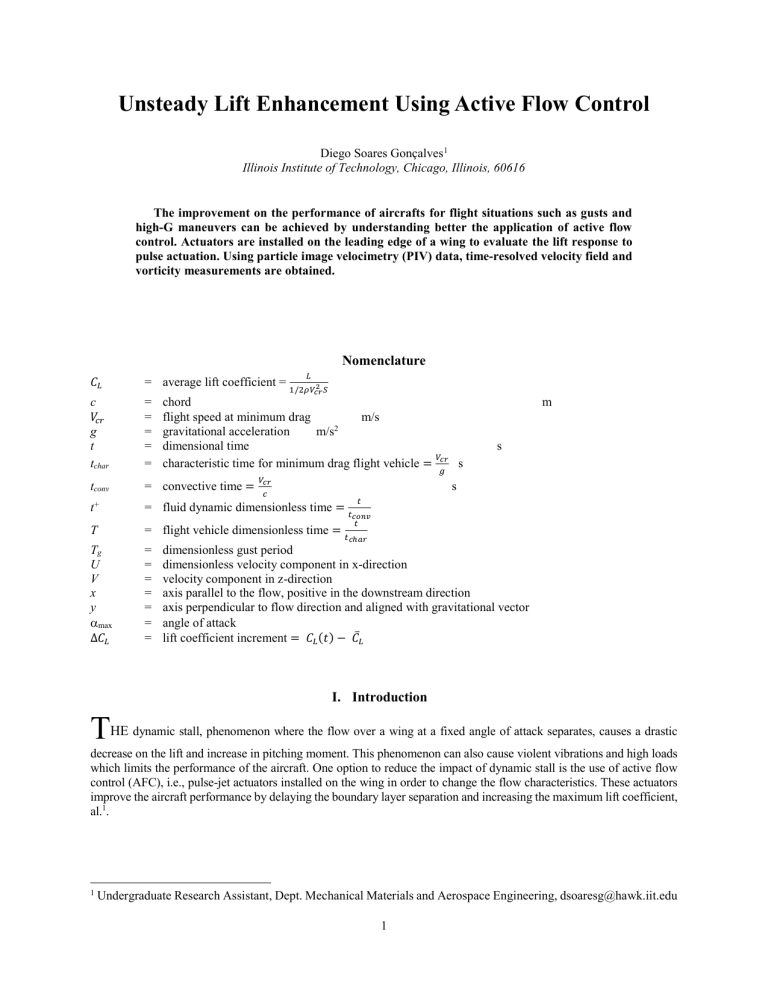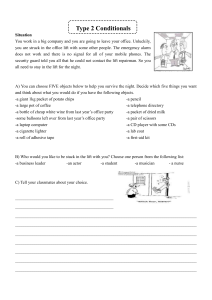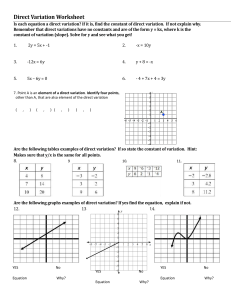
Unsteady Lift Enhancement Using Active Flow Control Diego Soares Gonçalves1 Illinois Institute of Technology, Chicago, Illinois, 60616 The improvement on the performance of aircrafts for flight situations such as gusts and high-G maneuvers can be achieved by understanding better the application of active flow control. Actuators are installed on the leading edge of a wing to evaluate the lift response to pulse actuation. Using particle image velocimetry (PIV) data, time-resolved velocity field and vorticity measurements are obtained. Nomenclature 𝐶𝐿 = average lift coefficient = c 𝑉𝑐𝑟 g t tchar = = = = = tconv = convective time = 𝐿 2𝑆 1/2𝜌𝑉𝑐𝑟 chord flight speed at minimum drag m/s gravitational acceleration m/s2 dimensional time 𝑉 characteristic time for minimum drag flight vehicle = 𝑐𝑟 s m s 𝑔 𝑉𝑐𝑟 s 𝑐 t+ = fluid dynamic dimensionless time = T = flight vehicle dimensionless time = Tg U V x y max ∆𝐶𝐿 = = = = = = = 𝑡 𝑡𝑐𝑜𝑛𝑣 𝑡 𝑡𝑐ℎ𝑎𝑟 dimensionless gust period dimensionless velocity component in x-direction velocity component in z-direction axis parallel to the flow, positive in the downstream direction axis perpendicular to flow direction and aligned with gravitational vector angle of attack lift coefficient increment = 𝐶𝐿 (𝑡) − 𝐶𝐿̅ I. Introduction THE dynamic stall, phenomenon where the flow over a wing at a fixed angle of attack separates, causes a drastic decrease on the lift and increase in pitching moment. This phenomenon can also cause violent vibrations and high loads which limits the performance of the aircraft. One option to reduce the impact of dynamic stall is the use of active flow control (AFC), i.e., pulse-jet actuators installed on the wing in order to change the flow characteristics. These actuators improve the aircraft performance by delaying the boundary layer separation and increasing the maximum lift coefficient, al.1. 1 Undergraduate Research Assistant, Dept. Mechanical Materials and Aerospace Engineering, dsoaresg@hawk.iit.edu 1 Figure 1. Dynamic lift response following actuator input. (a) Single pulse actuation. (b) Multi-pulse actuation. The dynamic lift response following the single pulse and multi-pulse actuations are shown in Figure 1. The lift increment has different responses according to the number and frequency of pulses and obtaining a solid understanding of the physics associated to these responses is the main objective of this paper. II. Experimental Setup The experiments were done on the Andrew Fejer Unsteady Flow Wind Tunnel, which is low speed wind tunnel. It has a 0.61m x 0.61m cross-sectional area and test section length of 3.1m. At the maximum velocity, 40m/s, the test section has a turbulence level of 0.03% and is capable of producing an unsteady flow component. The wind tunnel is equipped with an IDT ProVision PIV system capable of measuring 3 velocity components in a plane. Twin 200 mJ/pulse New Wave lasers are mounted on a sliding traverse on the top of the wind tunnel. A 0009 NACA wing with a 0.6m span and 0.245m chord length was used to perform the experiments. The wing was equipped with 8 piezoelectric actuators (40mm length each, spaced 74mm from each other) over the leading edge and surface pressure sensors at six chord-wise positions at the mid-span. The actuators jet emerged from two-dimensional slots, 40mm long and spaced 74mm from each other. The wing was adjusted with a 12° angle of attack and the PIV system was calibrated before starting the data acquisition. To capture images with good quality CARBOWAX TM PEG particles were used on the experiments. Studies in a closed loop wind tunnel has shown that PEG particles provides a very good signal initially, but the seeding disappears rapidly with time, et al.2, so a correction on the valve pressure was necessary to maintain the good quality of the images during the experiments. Figure 2. Experimental setup. The first image shows one of the piezoelectric actuators that were installed on the wing’s leading edge. The second image shows the wing equipped with the actuators. The third image shows the laser trigged, lighting the sending on the flow over the wing. 2 Control algorithms for the pulse-actuators were designed using SimulinkTM and implemented in DSP hardware using a dSPACE/ControlDeskTM1104 system. The computational power of the dSPACE system was capable of running 100 kHz sample rate. The single-pulse case and multi-pulse case were tested for a time period of 50 t + and for different laser trigger delay values. The pulse tested had a pulse interval of 1.75𝑡 + and a pulse width of of 0.12𝑡 + . III. Results Figure 3. Horizontal velocity field variation with time, showing the lift response to a single pulse actuation. Figure 4. Horizontal velocity field variation with time, showing the lift response to a multi-pulse actuation. 3 Figure 5. Vertical velocity field variation with time, showing the lift response to a single pulse actuation. Figure 6. Vertical velocity field variation with time, showing the lift response to a multi-pulse actuation. Figure 7. Vorticity field variation with time, showing the lift response to a single pulse actuation. 4 Figure 8. Vorticity field variation with time, showing the lift response to a multi-pulse actuation. IV. Discussion of Results The Figures 3 through 8 shows that the actuator produces a vortex that convects over the wing surface. The horizontal velocity flow field shows the flow detachment at 𝑡 + = 1.5 for both type of pulse actuation, although on the single pulse case this effect was more evident. The vertical velocity flow field shows two vortices on suction surface at minimum lift for both single-pulse and multi-pulse cases. The dynamic lift reversal occurs at 𝑡 + = 1.5 for both cases. No change was observed on the vertical velocity flow structure for the maximum (𝑡 + = 3) and minimum lift (𝑡 + = 1.5). The analyses of the vertical velocity flow field and vorticity flow field showed new vortex structures emerging at 𝑡 + = 7.1, 10.5 and 14 in the multi-pulse actuation, which are not observed with single pulse. This new vortex structure explains the dynamic lift oscillations. For the single-pulse case no new vortex formation was observed. V. Conclusions The use of the particle image velocimetry (PIV) allowed to identify differences in flow structure between single-pulse and multi-pulse actuation. Flow structures appeared to correlate with dynamic lift oscillations. Acknowledgments The airfoil experiments were performed in the Andrew Fejer Unsteady Flow Wind Tunnel in Illinois Institute of Technology (IIT). This work was supported by the U.S. Air Force Office of Scientific Research and by the Brazil Scientific Mobility Program (BSMP). The big support of Xuanhong An and Dr. David R. Williams are acknowledged. References 1Seifert, A., Bachar, T., Koss, D., Shepshelovits, M., and Wygnanski I., “Oscillatory Blowing – a Tool to Delay Boundary Layer Separation,” AIAA Journal, Vol. 31, No. 11, 1993, pp. 2052-2060. 2Stanislas, M., Kompenhans, J., Weterweel, J. (Eds.) (2000) Particle Image Velocimetry: Progress Toward Industrial Application. Kluwer: Dordrecht. 5



